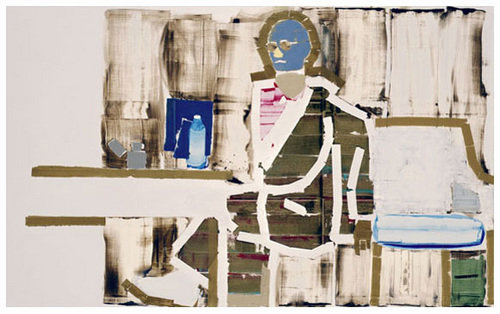Magnus Plessen
dal 23/11/2006 al 12/1/2007
Segnalato da
23/11/2006
Magnus Plessen
Mai 36 Galerie, Zurich
New Paintings. The german artist worked for several years as a photographer and filmmaker before turning to painting and its wide variety of possibilities in the year 2000. Photography is in fact a central aspect in his painting owing to its neutrality. He thus transposes photographs of everyday scenes, simple actions, portraits and architectural perspectives by simple means, with an immediate impact.

New Paintings
We have pleasure in presenting recent paintings by the German painter Magnus Plessen (born in Hamburg in 1967, lives and works in Berlin since 1999) at our next exhibition. Magnus Plessen worked for several years as a photographer and filmmaker before turning to painting and its wide variety of possibilities in the year 2000. Plessen's paintings are distinguished by an independent composition technique and a reduced visual language that are increasingly attracting the attention of the international art scene. The Galerie Mai 36 has been representing the artist since 2003.
Photography is a central aspect in the painting of Magnus Plessen owing to its neutrality, which the artist greatly appreciates. He thus transposes photographs of everyday scenes, simple actions, portraits and architectural perspectives by simple means, producing pictures with an immediate impact. Motifs that appear staged against a monochrome background may subsequently dissolve into it. Plessen then restores the self-portrait's unpainted areas, signifying the moment of dazzling blindness. The artist uses photography as a stimulus for remembering persons, events or places that he reactivates during the painting process. His inner images are converted through deconstruction and merely suggested by means of broad, thrifty, frequently streaky and precisely placed brush strokes executed with various degrees of pressure, sometimes vertical, sometimes horizontal, sometimes focused, and sometimes defining empty areas. The strokes constitute the image, and one single stroke often portrays much of what is happening in the picture. Frequently, they construct architecture out of wooden walls, in front of which stand isolated figures, often with an in-turned, shaded gaze, which sometimes seem to merge with the boards. In any case, they appear to be severely limited in their freedom of movement. The strokes of the brush, stratified horizontally, reduce the corporeality of the figures to two-dimensionality, thus abstracting them from their relation to the pictorial space. A vague sense of spatiality arises only where the parts of the bodies that become one with the pictorial surface tear open blank spaces in the layers of the brush strokes.
This is particularly evident in the self-portraits, where parts of the body emerging from the painted ground are only hinted at by fleeting strokes. They are set in a barely outlined inte'rieur. The face of the subject of the self-portrait is often completely withdrawn from the gaze of the spectator. The portrayals are thus neither unambiguously realistic, nor do they exist solely in the imagination. Finally, the expressive ductus helps to make the photographic element in the paintings almost unrecognisable. Apart from a few exceptions, the artist refrains from using any illusionist techniques in order to portray three-dimensionality. This is why his work is reminiscent of sketches or collages that nevertheless succeed in capturing the essential qualities of the motif and presenting it in an eloquent light. [Text: Dominique von Burg]
Image: Magnus Plessen "Mr. Davies 4-10-78", 2006,oil on canvas.
Mai 36 Galerie
Ramistrasse 37 - Zurich



